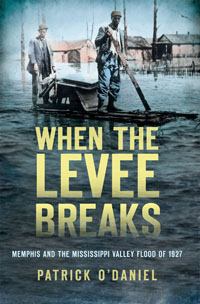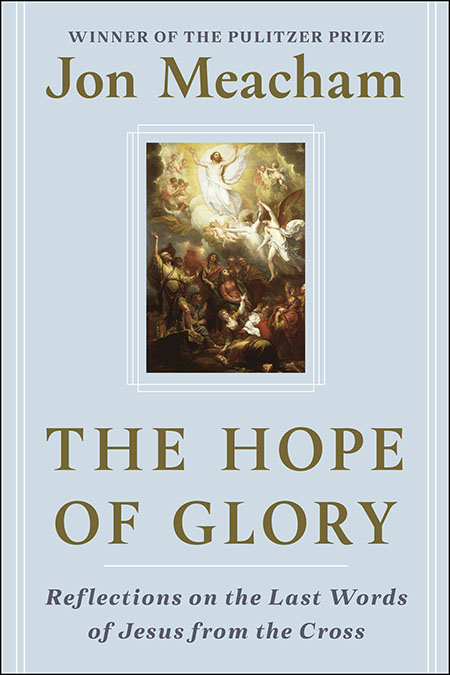Before FEMA
Memphis librarian Patrick O’Daniel considers the great Mississippi Valley Flood of 1927
When the Levee Breaks is Patrick O’Daniel’s comprehensive but concise treatment of one of the worst “natural” disasters of the twentieth century. In fact the great Mississippi Valley flood of 1927 was at least partially the result of a century of forest-clearing—to make way for farming and as a source of timber—in the Midwest. There had been bad floods before, most recently in 1913, and levees had been erected to contain the water and protect the fertile bottom land along the lower Mississippi River, where both plantation owners and small farmers alike struggled because of post-war low prices. The flood of 1927 was an unprecedented levee-breaker that killed hundreds of people and uprooted thousands more.
 The Red Cross, the Army Corps of Engineers, and state, federal, and local governments all pitched in to help with the recovery, and for the most part worked together reasonably well. President Calvin Coolidge, a small-government, fiscally conservative Republican, opposed federal action on principle and would not call a special session of Congress to appropriate funds for rebuilding. He did, however, send his Secretary of Commerce, Herbert Hoover, to Memphis to take charge and coordinate relief-and-rebuild efforts. Hoover’s management was marred by his acceptance of the plantation owners’ insistence that their African-American field hands, kept in a kind of peonage by the sharecropper system, not be removed to large, central refugee centers, where they might escape to northern cities. Their refugee camps often amounted to prisons, where “sheriff’s deputies and national guardsmen kept thousands of landless African American sharecroppers confined . . . to ensure they would eventually return to the plantations where they worked,” O’Daniel writes.
The Red Cross, the Army Corps of Engineers, and state, federal, and local governments all pitched in to help with the recovery, and for the most part worked together reasonably well. President Calvin Coolidge, a small-government, fiscally conservative Republican, opposed federal action on principle and would not call a special session of Congress to appropriate funds for rebuilding. He did, however, send his Secretary of Commerce, Herbert Hoover, to Memphis to take charge and coordinate relief-and-rebuild efforts. Hoover’s management was marred by his acceptance of the plantation owners’ insistence that their African-American field hands, kept in a kind of peonage by the sharecropper system, not be removed to large, central refugee centers, where they might escape to northern cities. Their refugee camps often amounted to prisons, where “sheriff’s deputies and national guardsmen kept thousands of landless African American sharecroppers confined . . . to ensure they would eventually return to the plantations where they worked,” O’Daniel writes.
 Given the nature of the times, this collusion between Hoover and the plantation owners to limit African-American options did nothing to limit Hoover’s own political ambitions. He used his high-profile role in the recovery as a springboard to launch his presidential campaign the next year. The mayor of Chicago also tried to use the flood for exposure and political capital. The mayor of Memphis, Rowlett Paine, played a large role in local refugee-relief efforts but was politically destroyed by bootleg and corruption scandals unrelated to the flood.
Given the nature of the times, this collusion between Hoover and the plantation owners to limit African-American options did nothing to limit Hoover’s own political ambitions. He used his high-profile role in the recovery as a springboard to launch his presidential campaign the next year. The mayor of Chicago also tried to use the flood for exposure and political capital. The mayor of Memphis, Rowlett Paine, played a large role in local refugee-relief efforts but was politically destroyed by bootleg and corruption scandals unrelated to the flood.
While O’Daniel’s analysis of the larger political, social, and economic fallout from the flood of 1927 is interesting, the core of When the Levee Breaks is in the details of when and where the levees broke, and who—by name in many cases—was swept away in the raging waters. He also names the rescuers, and their sometimes brave and dramatic exploits by steamer, rail, speedboat, or seaplane.
Racial aspects of the rescue efforts and refugee treatment are a welcome focus of When the Levee Breaks. “The citizens of Scott used every available automobile to transport white women and children to safety,” O’Daniel writes. Meanwhile, railroads “supplied two boxcars to move all the African American women and children.” In some cases, O’Daniel notes, “Rescuers picked up whites—and even mules—before blacks.”
Refugee camps were of course segregated by race, with the Red Cross “placing white families in the automobile building and African American families in the stock building,” writes O’Daniel. It’s a popular belief that the common experience of the flood brought whites and African Americans closer. Not so, according to acclaimed African-American novelist Richard Wright, who lived in Memphis in 1927. Wright argued that the treatment of African Americans during the flood destroyed any chance for improved race relations for decades to come.
Patrick O’Daniel will discuss When the Levee Breaks at The Booksellers at Laurelwood in Memphis on March 9 at 2 p.m.


